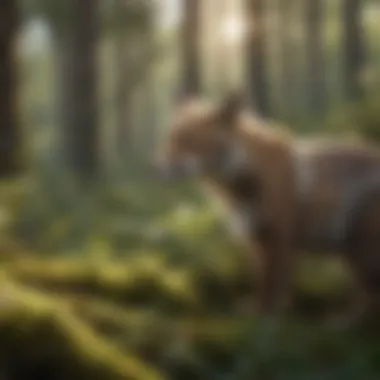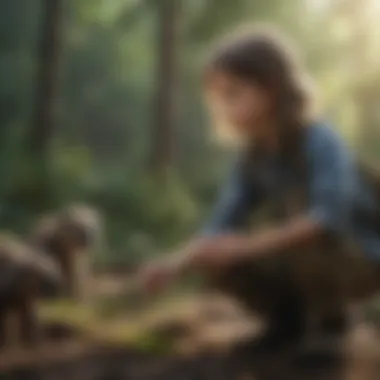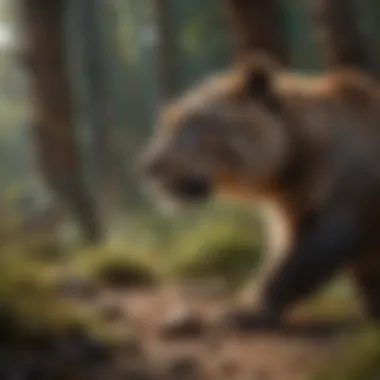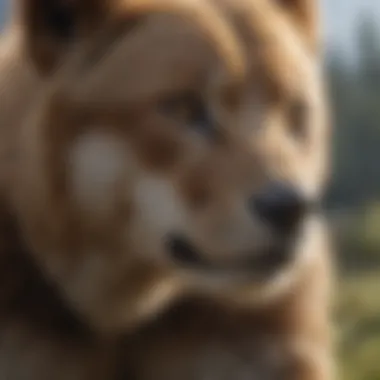Understanding Earth Day: Importance for Animals


Nature Topic Overview
Earth Day is an annual event celebrated on April 22. Its purpose is to demonstrate support for environmental protection. The day was first celebrated in 1970, and now it serves as a reminder of the responsibilities we have towards our planet. Animals play a crucial role in our ecosystems. They are not just part of nature; they help maintain the balance of our environment. This article will explore the significance of Earth Day, focusing on animals and their welfare. It will also cover how children can contribute to conservation efforts.
Understanding the Ecosystem
An ecosystem is the interaction between living organisms and their environment. Animals, plants, water, and soil all work together to create a balanced system. When one part of this system is disturbed, it can affect everything else. For example, pollution can harm wildlife, disrupting their habitat and food sources. Understanding this connection is key to appreciating why Earth Day is important.
Fun Facts and Trivia
Here are some interesting facts about animals and the environment:
- Polar bears are excellent swimmers. They can swim continuously for days to find food.
- Bees are vital for pollination. They help many fruits and vegetables grow.
- Some turtles can breathe through their backside. This helps them stay underwater longer.
Children can learn these facts through quizzes or visuals. Activities can include coloring pages featuring animals or puzzles about their habitats. This makes learning about Earth Day engaging and fun.
Wildlife Explorations
Exploring different animal species is essential for understanding Earth Day's importance. Here are a few examples:
- Oceans: Dolphins and sea turtles are significant for marine ecosystems. They help keep the ocean balanced.
- Forests: Animals like elephants and gorillas are keystone species. Their presence supports many other organisms.
- Grasslands: Bison and prairie dogs play important roles in their habitats, affecting plant growth and soil health.
Each of these habitats has unique features. For example, coral reefs are home to numerous fish and are critical for biodiversity. Children can engage with this information through quizzes or games related to the species they learn about.
Environmental Awareness
Conservation and sustainability are vital concepts for every child to understand. Here are some key points:
- Reduce waste: Simple actions like recycling can impact the environment positively.
- Save energy: Turning off lights when not needed helps reduce the carbon footprint.
- Learn about local wildlife: Knowing which species are in their area makes children more connected to their environment.
Children can also contribute to animal welfare. Activities such as planting trees, cleaning parks, or participating in local animal shelters can make a difference.
DIY Nature Activities
Hands-on activities encourage children to actively engage with nature. Here are some ideas:
- Nature Scavenger Hunt: Create a list of items like leaves, rocks, or animal tracks for kids to find outdoors.
- Bird Feeders: Use old milk cartons or cups to make bird feeders. This helps support local wildlife while providing a craft.
- Art Projects: Create nature-inspired art with materials collected outside, promoting appreciation for the environment.
These activities reinforce learning about animals and their habitats.
Remember, caring for animals and the environment is a lifelong commitment that starts with small actions. Every effort counts towards a healthier planet.
Prelude to Earth Day
Understanding Earth Day is essential for recognizing its significance, not just for the planet but particularly for animals. Animals play a vital role in the ecosystem. This day encourages us to reflect on our impact on the world and the living beings within it.
History of Earth Day
Earth Day was first celebrated on April 22, 1970. It arose from a growing awareness of environmental issues and a desire to advocate for the planet. The man behind this initiative was Senator Gaylord Nelson from Wisconsin. He observed the effects of pollution and environmental degradation. Many people participated, leading to a nationwide movement focusing on environmental issues. This day has since grown into a global celebration, with millions taking part each year. The origins are tied to protests and practices aimed to protect the environment, culminating in the establishment of the United States Environmental Protection Agency.
Purpose of Earth Day
The main purpose of Earth Day is to promote environmental awareness. It encourages individuals and groups to take action for the sustenance of our planet and all living beings. Each year, various events and activities occur worldwide to bring attention to environmental issues. This may include tree planting, clean-ups, or educational programs, focusing not only on the environment but on animals and their habitats as well.
This observance also serves as a reminder of the interconnectedness of all species on Earth. Animals contribute to the balance of ecosystems. If we neglect their needs, the entire system suffers. Thus, Earth Day is both a celebration and a call to action.
"The Earth does not belong to us; we belong to the Earth." – Marlee Matlin
Involvement in Earth Day can lead to sustainable practices that positively impact animals and their environments. By participating, we recognize our responsibility towards nature and its many inhabitants. Encouraging ongoing discussions about wildlife and conservation are also significant elements of this observance.


The Importance of Animals in Our Ecosystem
Animals play a crucial role in maintaining the balance of our ecosystem. Each species contributes to the health and stability of various habitats, from forests to oceans. When these animals thrive, the entire ecosystem benefits. From pollinators that help plants reproduce to predators that control prey populations, every animal has a distinct function that supports life on Earth.
Key Elements of Animal Importance in Ecosystems:
- Pollination: Creatures like bees and butterflies are essential for the pollination of many plants, which in turn provide food for other animals.
- Nutrient Cycling: Decomposers, such as earthworms and certain insects, break down dead organisms. This process returns vital nutrients to the soil, promoting plant growth.
- Natural Pest Control: Predatory species help regulate the populations of herbivores and pests, preventing damage to crops and plants.
As we explore this subject, we must acknowledge the interconnectedness of species. Each animal, no matter how small, plays a role in a complex web of life.
Biodiversity and Its Benefits
Biodiversity, which refers to the variety of life forms in a given ecosystem, is essential for a flourishing environment. A diverse ecosystem is more resilient, as it can withstand changes and recover from disturbances, such as natural disasters or human activities.
- Healthier Ecosystems: Greater biodiversity leads to more stable ecosystems. Different species act as checks and balances, promoting a healthy environment.
- Economic Value: Biodiversity contributes to industries such as agriculture, pharmaceuticals, and tourism. Many crops depend on various species for pollination and pest control.
- Cultural Significance: Many cultures have strong ties to natural species. They depend on them for food, materials, and even spiritual beliefs.
"Biodiversity is the foundation of ecosystem services that sustain and fulfill human life."
The more diverse an ecosystem is, the more benefits it can provide, making conservation even more critical.
Predators, Prey, and Food Chains
Predators and prey are integral to understanding ecosystem dynamics. The relationship between them creates a food chain that supports life. The food chain illustrates the flow of energy and nutrients through the environment.
- Energy Transfer: The transfer of energy begins with plants, who produce their own energy through photosynthesis. Herbivores consume these plants, and predators eat the herbivores. Each step in this chain is vital for maintaining the balance.
- Population Control: Predators help control the populations of prey species. Without predators, certain species can become overpopulated, leading to overgrazing and resource depletion.
- Feeding Relationships: Different animals occupy different levels in the food chain. This hierarchy is essential for resource distribution and ecosystem balance.
Understanding these relationships is crucial, especially as human activity often disrupts these natural dynamics. Wildlife conservation efforts are vital in restoring and sustaining these important interactions.
Endangered Species and Their Crises
Endangered species are those animals and plants that face a high risk of extinction in the wild. Understanding their plight is crucial for several reasons. Firstly, these species are often indicators of the health of the ecosystem. Their decline signals larger environmental issues that can affect other species as well, including humans. Secondly, the loss of biodiversity can disrupt food chains, leading to consequences that can ripple through the ecosystem. Therefore, studying endangered species is vital for promoting awareness and advocating for their conservation.
Classification of Endangered Species
Species are classified as endangered based on various criteria. There are categories that help determine their level of risk. The International Union for Conservation of Nature (IUCN) maintains a Red List that categorizes species into different levels:
- Critically Endangered: This group includes species facing an extremely high risk of extinction.
- Endangered: This refers to species at a high risk of extinction in the wild.
- Vulnerable: These species are at risk, but not yet critically endangered.
Each classification informs conservationists about priority actions needed for each species' recovery. Endangered species, like the Amur leopard or the Sumatran orangutan, require immediate attention due to their precarious circumstances.
Impact of Habitat Loss
Habitat loss is one of the foremost threats to endangered species. As human populations grow, land is cleared for agriculture, urban development, and other uses. This destruction fragments habitats, leaving species without homes. The effects of habitat loss are severe:
- Reduction in Food Sources: Many animals rely on specific plants or other animals for food. When their habitats disappear, food becomes scarce.
- Isolation of Populations: This makes it difficult for species to find mates, leading to reduced genetic diversity which can cause further decline.
- Human-Wildlife Conflict: As animals stray into human-inhabited areas in search of food or shelter, they often come into conflict with humans.
Addressing habitat loss requires significant effort, including restoration projects and sustainable land-use practices.
Climate Change Effects on Wildlife
Climate change poses another significant challenge for wildlife. As temperatures rise and weather patterns shift, animal habitats are changing, putting additional stress on vulnerable species. Key effects include:
- Shifts in Habitats: Many plants and animals cannot adapt quickly enough to the changing climate, leading them to relocate or perish.
- Altered Breeding Cycles: Changes in seasonality can disrupt the timing of breeding, which is vital for young animals' survival.
- Threats to Food Security: Changes in climate affect the availability of food resources, making survival more challenging.
Combating climate change is complex. It involves both reducing greenhouse gas emissions and developing strategies to help wildlife adapt to a changing environment.
"Protecting endangered species is not just about saving animals; it’s about preserving the ecosystems of which we are all a part."
Animals in Urban Environments
Understanding animals in urban environments is crucial to recognizing how wildlife adapts to change and how we impact their lives. Urban areas often provide unique challenges but also unexpected opportunities for many species. With populations increasing in cities, wildlife is forced to interact closely with humans. This section discusses the specific adaptations urban animals develop and highlights the consequences of human activities on their habitats.


Adaptations of Urban Wildlife
Urban wildlife showcases remarkable adaptability. Animals such as raccoons, squirrels, and pigeons have learned to thrive in city settings. They find food and shelter in places that may not seem suitable. For instance, raccoons raid trash cans while pigeons nest in ledges of buildings. These adaptations include:
- Dietary Flexibility: Urban animals often have varied diets, allowing them to eat what is available. This might include leftover human food or pests like rats.
- Nest Construction: Many species modify their nesting habits. For example, some birds may choose to build nests in man-made structures rather than trees.
- Behavioral Changes: Urban animals become more nocturnal. This change helps avoid human encounters, making it easier for them to find food and roam freely.
The ability to adapt is critical for survival, but it does not come without risks.
Human Impact on Urban Animal Habitats
Humans significantly influence urban animal habitats. Urbanization often leads to habitat destruction, affecting wildlife populations. Key impacts include:
- Loss of Natural Habitats: As cities expand, natural environments shrink. This leads to fewer resources for animals.
- Pollution: Chemicals and waste can create unsafe living conditions. Animals may struggle with toxins that cause health issues.
- Traffic Hazards: Roads and vehicles pose dangers. Many animals, like deer and turtles, face risks when crossing roads.
- Noise and Light Pollution: Increased activity at night can disrupt animal behaviors, such as breeding and feeding.
"Urban ecosystems reflect the resilience of wildlife. Yet, they remind us of our duty to coexist responsibly."
Recognizing the effect of our actions on urban wildlife is essential for fostering coexistence. Simple behaviors can help preserve these species, such as:
- Reducing litter to prevent wildlife from ingesting harmful materials.
- Creating green spaces that support diverse habitats.
- Educating others about respecting wildlife.
Ultimately, understanding urban wildlife and the challenges it faces is an important step in conservation. We all play a part in ensuring their survival among us.
Conservation Efforts on Earth Day
Conservation efforts are essential for sustaining the planet. This is especially true on Earth Day, which serves as a reminder of our responsibility to protect our environment and the animals living within it. These efforts can take many forms. They often involve both local and global actions aimed at preserving habitats, educating communities, and encouraging responsible behaviors. Understanding conservation is crucial, especially for children, who will inherit the Earth’s challenges. This section will discuss significant initiatives that contribute to wildlife preservation.
Local Animal Shelters and Their Work
Local animal shelters play a vital role in conservation, focusing on the welfare of homeless and abandoned animals. These organizations not only provide safe havens for animals but also promote adoption, ensuring that pets find loving homes. The work done by shelters includes:
- Rescue Operations: Shelters are involved in rescuing animals in distress, often due to neglect or abandonment. They provide medical care and rehabilitation.
- Educational Programs: Many shelters offer programs to teach the community about responsible pet ownership. Topics can include spaying and neutering, proper care, and prevention of cruelty to animals.
- Volunteer Opportunities: Children and families can get involved by volunteering at shelters. This hands-on experience fosters compassion and a sense of responsibility towards animals.
"Every small effort counts. By helping local shelters, we contribute to a larger mission of animal welfare and conservation."
Through these activities, local animal shelters make a direct impact on the lives of animals while also educating the public. This blend of care and awareness is crucial in achieving long-term conservation goals.
Global Initiatives for Wildlife Preservation
On a broader scale, several global initiatives aim to protect wildlife and their habitats. Organizations like the World Wildlife Fund and Conservation International focus on a variety of strategies to combat threats to endangered species. Key initiatives include:
- Habitat Protection: Many programs work to establish protected areas where animals can thrive without human interference. This helps preserve ecosystems that are crucial for biodiversity.
- Legislation and Advocacy: Global efforts often include lobbying for laws that protect endangered species and their habitats. This includes regulations against poaching and illegal trade.
- Community Involvement: Engaging local communities to participate in conservation efforts is important. Many organizations train local people to become stewards of their environment, ensuring sustainable practices.
- Research and Monitoring: Ongoing studies and tracking of wildlife populations help to inform conservation strategies. Understanding animal behavior and migration patterns is essential for creating effective protection plans.
These global initiatives highlight how intertwined our actions are with the health of the planet. By participating in Earth Day activities and supporting these efforts, children, parents, and educators can play a fundamental role in the conservation narrative.
How Kids Can Make a Difference
Kids have a unique position when it comes to making a difference for animals and the environment. Their enthusiasm and energy often inspire others around them. Young individuals bring fresh perspectives and ideas that can be vital in promoting animal welfare. By engaging in small acts of kindness and participating in volunteering opportunities, children can contribute significantly to their communities and the ecosystem. It is essential for both parents and educators to recognize this potential and foster a sense of responsibility in children towards animals and their habitats.
Simple Acts of Kindness Towards Animals
Every day, kids can perform simple yet impactful acts of kindness that support animal welfare. These activities do not require special skills or equipment, making them accessible to all children.
- Feeding Birds: Placing bird feeders filled with seeds in the yard supports local bird populations. Watching birds can also spark a child’s interest in nature.
- Helping Shelter Animals: Donating old toys, blankets, or food to animal shelters can provide comfort to animals in need. Kids can host small collection drives with their friends.
- Picking Up Litter: Keeping parks and neighborhoods clean helps protect the habitats of many animals. Kids can organize community clean-up days or simply gather litter during family outings.
- Creating Safe Spaces: Making a small home garden can attract helpful insects and provide shelter for local wildlife. Kids can learn about different plants and their benefits for local ecosystems.
These simple acts show kids that they can have a real impact on animals' lives without requiring large-scale efforts. Each small deed contributes to a bigger movement towards animal welfare.
Volunteering Opportunities
Volunteering offers children hands-on experience and a deeper understanding of animal welfare. Engaging with local organizations can keep kids motivated and informed about various species and their needs. Here are a few volunteering opportunities:
- Animal Shelters: Many shelters welcome young volunteers to help with tasks like walking dogs, feeding animals, or cleaning facilities. This experience can teach children about the care animals need.
- Wildlife Rehabilitation Centers: Some centers allow kids to assist with education programs or help care for injured animals, providing crucial support for rehabilitation efforts.
- Community Nature Programs: Local parks and nature organizations often host events. Kids can volunteer to help with educational programs, park maintenance, and species monitoring.
- Conservation Projects: Participating in local conservation projects can help kids understand ecological balance and the urgency of protecting various habitats.


Such opportunities encourage kids to connect more deeply with nature and animals. They learn valuable skills while contributing positively to their local communities and the ecosystem.
"Every small effort counts in making a positive impact on the lives of animals. Kids can be the change that our planet needs."
By nurturing their passion and awareness for animal welfare, children can truly make a significant difference on Earth Day and beyond. Involving them in such activities builds a strong foundation for a future dedicated to environmental responsibility.
Learning Resources for Young Environmentalists
Learning resources play a crucial role in helping young minds understand the importance of Earth Day and the role animals play in our ecosystem. By engaging with designed materials, children aged 5 to 12 can cultivate their awareness and action towards a sustainable world. This section highlights various effective resources that not only inform but also inspire the youth to care for animals and the environment.
Books and Documentaries about Animals
Books and documentaries offer a wealth of knowledge about animals and their habitats. They stimulate curiosity and encourage young readers and viewers to explore various species and their environments.
- Children's Books: Titles such as "The Berenstain Bears Don't Pollute" or "Wangari's Trees of Peace" introduce topics related to ecology and conservation in a way that resonates with young audiences. Such stories engage children emotionally, making them more likely to remember and act on the lessons they learned.
- Documentaries: Shows like "Our Planet" or "The Blue Planet" provide stunning visuals and essential information about wildlife. Watching these documentaries can spark discussions about climate change effects on animals, which is an important facet of Earth Day.
By choosing the right books and documentaries, parents and educators can facilitate vital conversations about environmental responsibilities.
Interactive Online Platforms for Kids
Many online platforms cater specifically to young environmentalists. These resources combine education with interactivity, making learning enjoyable.
- Educational Websites: Platforms like National Geographic Kids and PBS Kids feature games, videos, and articles that focus on wildlife and ecology. Through interactive quizzes and activities, children can learn about endangered species and their conservation.
- Apps for Conservation: Applications such as "Marine Biology for Kids" entertain while educating users about ocean life. These apps offer facts, images, and games to reinforce learning.
- Online communities: Websites like Reddit have forums dedicated to environmental education. Children can pose questions and share ideas with like-minded peers, fostering a sense of belonging and collaboration.
These platforms are essential for young environmentalists. They ensure that the pursuit of knowledge about animals and conservation remains engaging and impactful.
"Informing our children gives them the tools necessary to advocate for the planet and its creatures."
Introducing children to these learning resources can empower them to become the stewards of our planet that we need for a sustainable future.
The Role of Parents and Educators
Parents and educators play a crucial role in shaping the environmental consciousness of the younger generation. Their influence can significantly affect how children perceive wildlife and their responsibility towards it. By engaging in discussions about animals and their habitats, adults can foster a sense of empathy and respect for all living beings. Children learn best through examples set by adults, making it essential for parents and educators to model environmentally friendly behaviors themselves.
Encouraging Conversations about Wildlife
Dialogue about wildlife can begin at home and in classrooms. Parents can introduce the topic of animals in simple ways, such as observing birds in the garden or discussing pets in the household. Educators can incorporate lessons about local wildlife into the curriculum. Questions can spark curiosity:
- What animals live in our area?
- How do they adapt to changes in their environment?
- Why are some species endangered?
Encouraging children to share their thoughts and experiences can cultivate a deeper interest in animals. Field trips to nature reserves or zoos can also enhance this learning, providing concrete examples of wildlife. These opportunities allow children to witness the importance of conserving habitats firsthand.
Setting an Example Through Action
Actions speak louder than words. When parents and educators engage in environmentally friendly practices, they set a powerful example. Simple actions like recycling, conserving water, and using reusable bags can inspire children to adopt similar habits. Volunteering for local wildlife organizations or participating in community clean-up efforts showcase direct involvement in conservation.
Moreover, discussing the impact of climate change and habitat loss makes these issues more tangible. Families and schools can organize projects that focus on animal welfare. For instance, they can build birdhouses or plant native species to attract local wildlife.
Ultimately, it is critical for parents and educators to instill a sense of responsibility in children. Teaching them that every small action can contribute to larger conservation efforts empowers them to be active stewards of the environment.
Epilogue: A Collective Responsibility
In considering our role regarding animals and the environment, it is essential to recognize that the responsibility is not solely on the shoulders of governments or large organizations. Instead, it lies with each individual, including families, schools, and communities. Awareness of Earth Day serves as a reminder that every action can contribute positively or negatively to the world around us.
Reflection on Our Role as Stewards of the Earth
As stewards of the Earth, our daily choices matter. Taking an active stance in protecting animals and their habitats can be as simple as making more informed consumer choices, such as choosing sustainable products where possible. Additionally, understanding the impact of pollution and waste on animal life is crucial.
"The Earth does not belong to us; we belong to the Earth."
Educating children about conservation begins with parents and educators who guide discussions about wildlife and their importance. Facilitating conversations can inspire a sense of responsibility in young minds. When children see their parents engage in environmental actions—like recycling, planting trees, or volunteering—they learn by example.
It's equally important to remind the younger generation that conservation does not need to be overwhelming. Here are a few simple actions that can reinforce a sense of duty:
- Reduce plastic use: Encourage the use of reusable bags and bottles.
- Support local wildlife shelters: Donations or volunteerism can have a direct impact on local animal welfare.
- Engage in nature: Plan family outings to parks or nature reserves to foster an appreciation for wildlife.
The real challenge lies in making these principles a habitual part of life. Instilling values of respect and care for animals in children fosters a generation that will hopefully lead in the fight against habitat destruction and species extinction. By working collectively, we create a positive cycle that can sustain our environment for future generations.







